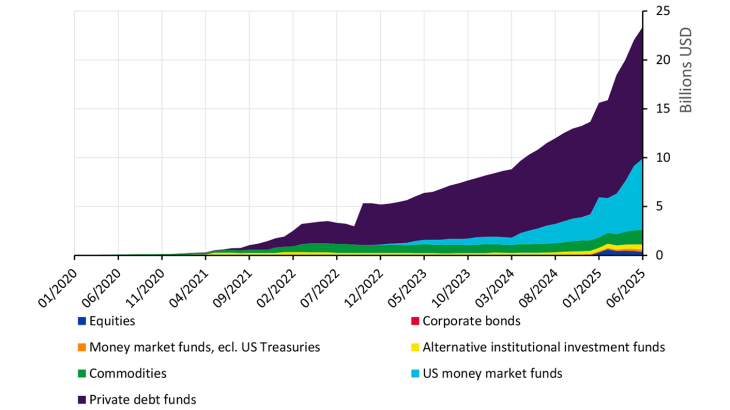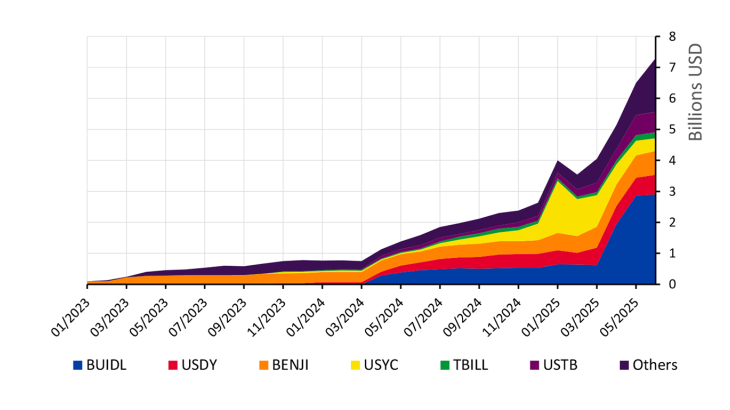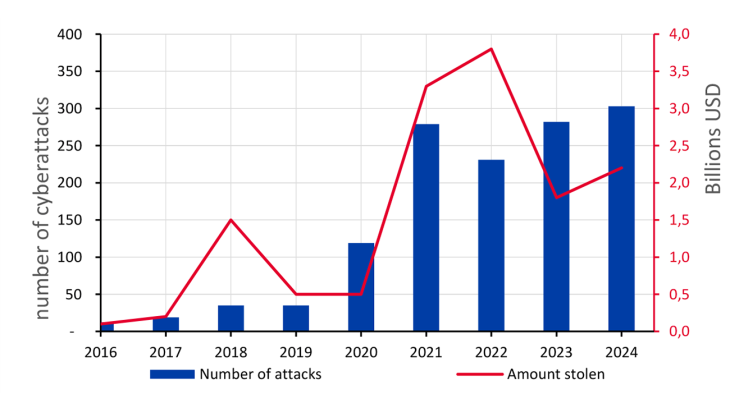- Home
- Publications et statistiques
- Publications
- Tokenised money market funds: what are t...
Tokenised money market funds: what are the implications for financial stability?
Post No. 408. 2024 witnessed a proliferation of fund tokenisation initiatives, particularly the tokenisation of money market funds. If this trend were to continue, it could increase the degree of interconnection between the traditional financial system and the cryptoasset sector, ultimately leading to new risks for financial stability.
Chart 1: Market capitalisation of tokenised real assets

Note: This chart presents all tokenised asset classes excluding stablecoins
Tokenisation of money market funds: a new bridge between traditional and tokenised finance
Asset tokenisation refers to the process of issuing and recording an asset in digital form, using a database distributed within a community of users, known as distributed ledger technology (DLT). Tokenised money market funds are similar to traditional money market funds, but differ in their modus operandi. Their legal nature and return remain identical to those of a traditional money market fund. The novelty lies in the recording of fund units in the form of tokens traded on distributed ledgers rather than with a central securities depository as is the case with traditional money market funds. This allows automated operations - using computer programmes known as smart contracts - to reduce costs and speed up transactions.
In terms of market capitalisation, the securities most commonly converted into tokens, ahead of money market funds, are private debt funds (Chart 1), which are mainly invested in fintechs, real estate projects and small businesses in emerging countries. The tokenisation of money market funds holding US Treasuries is growing especially rapidly in the US market, with capitalisation of more than USD 7 billion in June 2025, compared with only USD 100 million at end-2022 (Chart 2). Moreover, the US market has witnessed an increase in the number of tokenised fund managers since 2024, although it remains relatively concentrated, as the market is mainly shared by four major tokenised money market funds. In Europe, the market remains very small at present. Although, the tokenised money market fund market accounts for around 0.1% of the traditional money market fund market, which is worth over USD 7 trillion.
The characteristics of a tokenised money market fund are comparable to those of a stablecoin in several respects: the short-term assets in which tokenised money market funds are invested are similar to the highly liquid assets that comprise stablecoin reserves, including short-term US Treasuries; just like stablecoins, tokenised money market fund units are easily transferable.
However, there are also differences between these two types of assets. Unlike stablecoins, tokenised money market funds provide a return, generally the yield on US Treasuries (4.4% for US 10-year Treasuries maturing in June 2025) through daily interest payments - or even by the second for certain funds - 365 days a year. However, tokenised money market funds may be less liquid than funds for stablecoins, depending on the type of tokenised fund, the liquidity of the assets themselves and the contractual terms and conditions.
Chart 2: Market capitalisation of tokenised money market funds invested in US Treasuries

The tokenisation of money market funds could ultimately pose risks to financial stability
The tokenisation of money market funds could create new contagion channels to financial markets, even though outstanding amounts remain low for the present.
The tokenisation of money market funds creates news interconnections between the cryptoasset ecosystem and the traditional financial system via tokenisation redemption mechanisms (Federal Reserve, 2023). For example, during periods of high volatility in the cryptoasset market, cryptoasset holders are likely to buy stablecoins in order to stabilise the value of their portfolio. In the future, instead of buying stablecoins, they may prefer to buy into tokenised US money market funds, which have the advantage of providing a return while remaining within the tokenised sphere. When volatility declines, they could convert these fund units into legal tender, which could require the money market fund manager to sell off the underlying US Treasuries, thereby driving down the value of US Treasuries.
The permanent availability of tokenised asset trading platforms introduces a risk of asset prices’ gap between the two markets as well as a potential risk of liquidity mismatch if it is possible to redeem tokenised money market funds 24/7. In the event of a spike in redemption requests outside traditional market trading hours, the issuer would be unable to liquidate the underlying assets to meet demand. Because the smart contracts used for tokenised money market funds automatically activate triggers when certain parameters are reached, they could amplify contagion to traditional international markets in a similar way to stablecoins. Nevertheless, the risks appear to be contained for the moment as the tokenised money market fund market remains quite small (Banque de France, 2024).
In addition, tokenised money market funds are subject to technological risks specific to cryptoassets, including stablecoins. The dispersion of tokenised fund units across different distributed ledgers with limited interoperability, fragments liquidity and complicates operations (OCDE, 2025).Moreover, the concentration of service providers can create vulnerabilities in the event of an incident and increase the risk of monopoly. Lastly, DLT can be vulnerable to cyberattacks that target smart contracts, as evidenced by the record amounts stolen in the cryptoasset sector since 2021 (Chart 3).
Chart 3: Cyber attacks targeting the cryptoasset sector

In dealing with these risks, the key challenge is to develop an evolving regulatory framework
In the European Union, the Markets in Crypto-Assets Regulation (MiCA) and the DLT Pilot Regime both aim to provide legal frameworks adapted to the use of DLT. The MiCA regulation covers cryptoassets, including stablecoins. The DLT Pilot Regime specifically aims to provide a three-year derogatory regulatory framework, renewable once, in order to experiment with tokenised security trading and post-market activities. Traditional financial regulations continue to apply to tokenised securities, according to the “same risks, same rules” and “technological neutrality” principles, whereby tokenisation does not affect their status as financial instruments and therefore the applicability of the relevant regulations.
Consequently, tokenised money market funds created in the EU – which have the characteristics of and risks associated with money market funds – are subject to the same specific rules as traditional money market funds set out in the Money Market Fund Regulation (MMFR). The MMFR harmonises prudential requirements for European money market funds and imposes governance and transparency rules on fund managers to ensure investor protection.
Moreover, units in tokenised money market funds, although issued in the form of tokens on DLT, are classified as financial instruments and are therefore not covered by the MiCA Regulation.
At the international level, efforts are continuing to assess whether existing regulatory frameworks adequately deal with the characteristics of different tokenised financial assets (e.g. the prudential framework, operational risk, cyber risk, third-party management). For the Financial Stability Board (FSB), the first task is to address the lack of data and information on the development of tokenisation and to facilitate the sharing of cross-border regulatory and supervisory information on this technology. In this regard, access to open-source data, particularly from DLT platforms, is essential for risk monitoring
(FSB, 2024).
Download the full publication
Updated on the 27th of October 2025